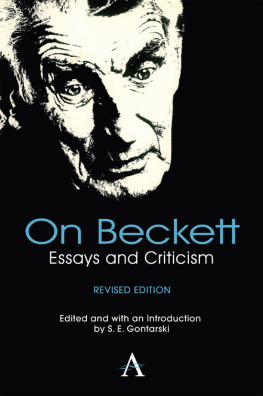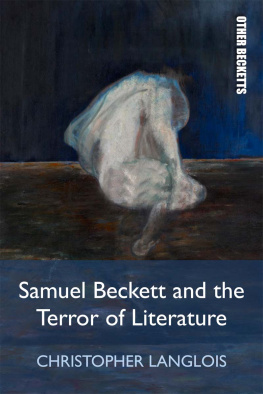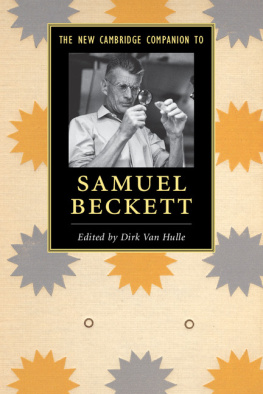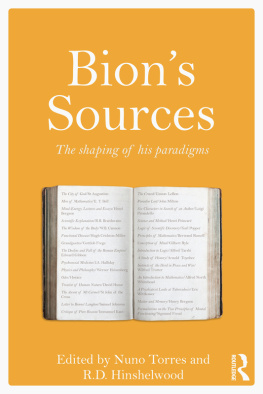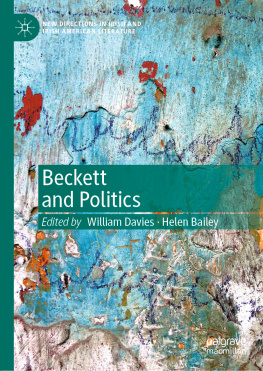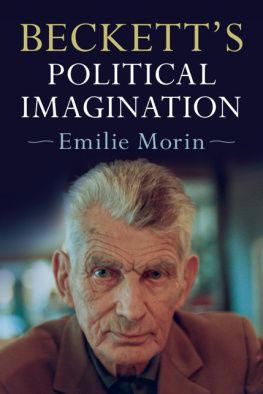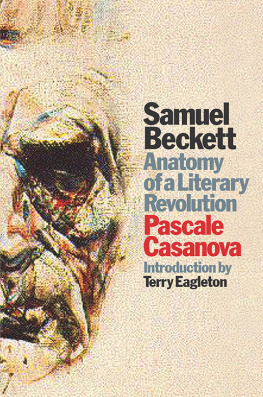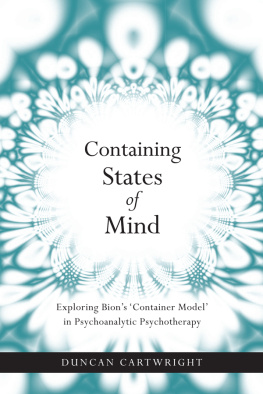BECKETT AND BION
The (Im)Patient Voice in Psychotherapy and Literature
Ian S. Miller
with contributions by Kay Souter
KARNAC
First published in 2013 by Karnac Books Ltd
118 Finchley Road, London NW3 5HT
Copyright 2013 to Ian S. Miller and Kay Souter.
The rights of Ian S. Miller and Kay Souter to be identified as the authors of this work has been asserted in accordance with 77 and 78 of the Copyright Design and Patents Act 1988.
All rights reserved. No part of this publication may be reproduced, stored in a retrieval system, or transmitted, in any form or by any means, electronic, mechanical, photocopying, recording, or otherwise, without the prior written permission of the publisher.
British Library Cataloguing in Publication Data
A C.I.P. for this book is available from the British Library
ISBN 978 1 78049 147 9
Edited, designed and produced by The Studio Publishing Services Ltd
www.publishingservicesuk.co.uk
e-mail: studio@publishingservicesuk.co.uk
Printed in Great Britain
www.karnacbooks.com
ACKNOWLEDGEMENTS
Because there are two of us, acknowledgement must begin with the stimulation, productivity, frustrations, confrontations, and working through of the pair, engaged in thought. Linked to Beckett and Bion, working with each other has been an exercise in continuously finding the Other, as well as serving as the Other's Other, and, most of the time, good enough. The challenges of international collaboration have been mitigated by technology, but, at bottom, it still comes down to voice and presence.
There are other Others, as well, to thank, beginning in New York with Annette and Zach, Laura, and Gil, whether encouraging or tolerating the passions of such enquiry. Continuously present in Melbourne, a shout out to Allan. And in Ireland, Conor and Judy, Christine and James J, leading to Sam at TCD.
Finally, often present, however absent, is the influence of my late teacher, William Grossman, MD.
I also acknowledge the following:
Cambridge University Press: extracts from The Letters of Samuel Beckett, Vol 1, 19291940 (2009), edited by Martha Dow Fehsenfeld and Lois More Overbeck, The Estate of Samuel Beckett 2009, published by Cambridge University Press, reproduced with permission.
Faber and Faber Ltd: permission to reproduce extracts from Molloy and The End, by Samuel Beckett.
Grove Press: excerpts from The End, Texts for Nothing, First Love, The Calmative, The Expelled, and One Case in a Thousand from The Complete Short Prose 19291989, copyright 1995 by the Estate of Samuel Beckett; excerpts from Molloy, English translation copyright 1955 by the Estate of Patrick Bowles and the Estate of Samuel Beckett; excerpts from The Unnamable, English translation copyright 1958 by the Estate of Samuel Beckett; excerpts from Company copyright 1980 by Samuel Beckett; excerpts from Worstward Ho copyright 1983 by Samuel Beckett; excerpts from Proust from Poems, Short Fiction, Criticism (Vol IV), copyright 2006 by the Estate of Samuel Beckett; excerpts from Watt, copyright 1953 by the Estate of Samuel Beckett; excerpts from Waiting for Godot, copyright 1954 by the Estate of Samuel Beckett; excerpts from Endgame, English translation copyright 1957 by the Estate of Samuel Beckett; excerpts from Bram Van Velde from Disjecta, copyright 1984 by Grove Press, Inc, used by permission of Grove/Atlantic, Inc.
ABOUT THE AUTHORS
Do you take your work home with you? had been a question often asked by patients in over thirty years of Ian Miller's clinical practice as a psychologist and psychoanalyst. Very surprisingly, as he listened one evening to Conor Lovett's Gare St Lazare Ireland performance of Beckett's First Love, the answer seemed to be a resounding yes. That resonant experience was the beginning of this project.
Ian's undergraduate education at the University of Pennsylvania focused on historical analysis of ancient manuscripts. His Doctorate in Clinical Psychology was followed by psychoanalytic training at the New York University Postdoctoral Program in Psychotherapy and Psychoanalysis. He is currently based in Dublin, where he maintains a psychotherapy practice. He is a member of the Irish Forum for Psychoanalytic Psychotherapy.
Kay Souter's experience has mirrored Ian's, with emphases reversed. She is a literary critic and educator, and has taught English literature at universities in Australia for over thirty years.
In the 1980s, she decided to learn more about psychoanalysis, and promptly found herself introduced to the work of W. R. Bion, whose extraordinary approach not only resonated for her, but also allowed her to explain Samuel Beckett to the drama students she was working with at the time. She has published widely on psychoanalysis and representations of the family, and in recent years her work on Bion has allowed her to focus on learning space development. She is based in Melbourne, where she works at Deakin University. At the weekends, she works in the small family vineyard in the foothills of the Australian Alps.
Introduction
This reading of Beckett and Bion is not simply interpretative, but a construction that has arisen from a very dynamic process, full of hypothesis and surprise. Far from negating other readings, it only adds density to the textured understanding of these two brilliant thinkers, each formally in different lines of work, but joined through what Bion himself might call a reciprocal perception of psychoanalysis. It is reciprocal because Beckett transformed psychoanalytic thinking into a literary genre while Bion transformed psychoanalytic thinking into process understanding. Each utilised the same object, but with different attentions to different ends.
Our collaboration began fortuitously, over a bottle of Souter Vineyard cabernet, after meeting at an international conference in Melbourne where Kay was a keynote speaker and I gave a paper. Somewhere approaching the lees, we got to talking about Beckett and Bion. Ian had recently seen Conor Lovett perform in First Love, and had a strong intuition about the narrative's clinical underpinning. He had begun reading Beckett biographies as well as psychoanalytic papers about the BeckettBion relationship. Kay's interest in Bion had long informed her teaching and writing (Souter, 2009).
Each agreed that something had gone missing in scholars' understanding of the BeckettBion relationship. Most glaring to us, as we began a second bottle, was a lack of critical thought concerning both the nature of Bion's Tavistock training at the time of Beckett's therapy and what, from the standpoint of now current theory, seemed to be Bion's violation of therapeutic boundaries in inviting his patient to dinner and a Jung lecture in October 1935.
Additionally, Beckett's own documented and prolific reading in psychoanalysis seemed nowhere to have been noted as a potential resistance to psychotherapy. In fact, it seemed to us as if the community of Beckett scholars, while mindful of psychoanalysis, had approached it as a theory alone rather than as an experiential clinical practice, and that the community of psychoanalysts, while mindful of the BionBeckett linkage, had insufficiently documented the terrific shifts in psychoanalysis, theory and training, both informing this early psychotherapy and subsequent developments in the field.
We agreed to collaborate on what was initially, to be a paper; so the work began. Biographies were invaluable, especially Knowlson's brilliant Damned to Fame, which allowed us to hypothesise about the young Beckett's emotional situation. Crucial to our research were Fehsenfeld and Overbeck's recently edited compilations of Beckett's correspondence. Reading them chronologically provided a rich resource in tracking Beckett's emerging thought and emotion, over time. Especially interesting to us were the many letters written during the period of Beckett's psychotherapeutic encounters with Bion. These provided an extra-therapeutic window on the treatment, from which, together with biographical materials, our changing hypotheses might be extended.
Next page

